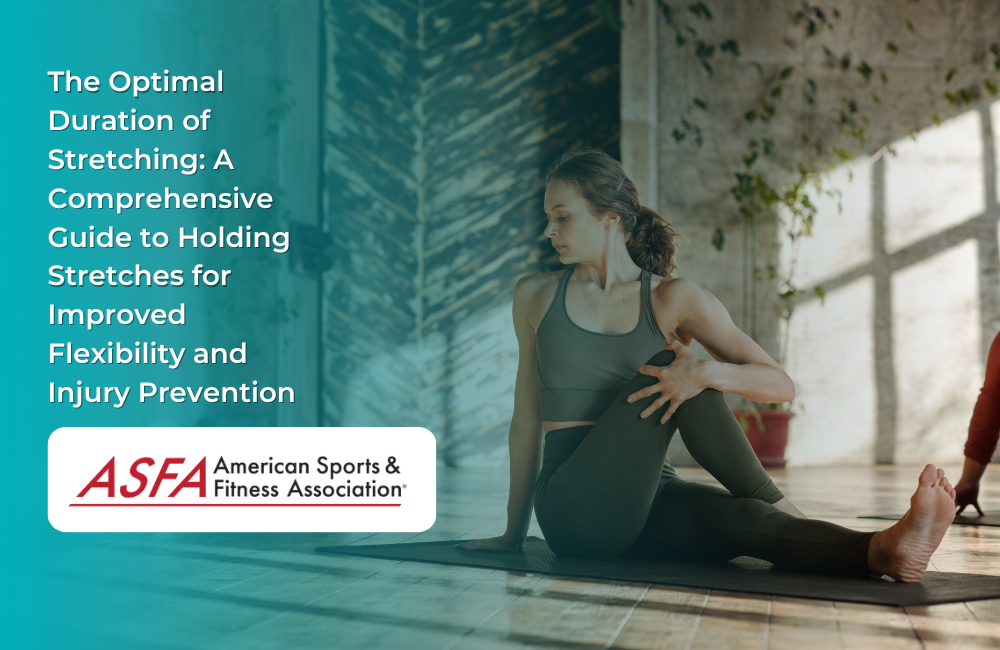Stretching is a key component of any well-rounded fitness routine, serving as a means to improve flexibility, enhance athletic performance, and reduce the risk of injuries. Recognizing its importance, the American Sports and Fitness Association (ASFA) encourages fitness professionals and enthusiasts to understand the optimal duration for holding stretches, as well as the various stretching techniques that can be employed. In this comprehensive guide, we’ll dive into the benefits of stretching, different stretching methods, the duration of stretching, and tips for incorporating this knowledge into your fitness routine to achieve better flexibility and overall well-being.
The Benefits of Stretching
Stretching offers a wide array of benefits that can positively impact overall fitness and health. Here's why stretching is an essential part of any exercise regimen:
Improved Flexibility
Regular stretching increases the range of motion in your muscles and joints. This enhanced flexibility can make daily movements easier, while also improving performance in sports or physical activities that require greater mobility. Stretching the hamstring muscle group, in particular, can significantly impact flexibility and range of motion, as various studies have shown.
Enhanced Performance
Flexible muscles and joints can work more efficiently and generate more power during physical activities. Athletes often notice better movement fluidity, quicker reaction times, and increased endurance when they incorporate regular stretching into their routine.
Injury Prevention
One of the most important reasons to stretch is to prevent injuries. Proper stretching helps reduce the likelihood of muscle strains, ligament sprains, and other exercise-related injuries. When muscles are flexible and joints can move smoothly through their full range of motion, the risk of overextending or pulling muscles is minimized.
Types of Stretching Techniques
There are several types of stretching techniques, each suited to different stages of a workout or recovery.
Static Stretching
Static stretching involves holding a stretch in a fixed position for a set period of time. This technique allows the muscles to relax and lengthen, promoting flexibility. Static stretching is most effective when performed after a workout during the cool-down phase, when muscles are warm and pliable. It is important to incorporate static stretching into exercise routines, especially for older adults and orthopedic patients, as it can be beneficial for improving mobility and aiding in rehabilitation.
Dynamic Stretching
Dynamic stretching involves moving parts of the body through a full range of motion in a controlled, repetitive manner. This technique mimics the movements performed during physical activities, making it ideal for warming up before exercise. Dynamic stretching prepares the muscles and joints for activity by increasing blood flow and improving neuromuscular coordination.
The Duration of Holding Stretches
The length of time you hold a stretch can significantly impact its effectiveness. Here’s a breakdown of the recommended durations for both static and dynamic stretches:
Additionally, the ability to tolerate more stretching force can lead to an increased range of motion, as it emphasizes increased stretch tolerance rather than an actual increase in muscle length.
1. Static Stretching
-
Recommended Time: Research suggests that holding static stretches for 15-60 seconds per muscle group provides the most benefits.
-
Optimal Duration: Holding each static stretch for around 30 seconds is considered ideal for most individuals. This duration allows the muscle to fully relax and elongate without risking overstretching.
-
Gradual Progression: For beginners, it's wise to start with shorter durations (about 15 seconds) and gradually increase the time as flexibility improves. Stretching too aggressively or for too long can lead to muscle strains or injuries, especially in individuals with lower flexibility.
2. Dynamic Stretching
-
Recommended Time: Dynamic stretches are typically performed for 10-15 repetitions of each movement.
-
Optimal Duration: Each dynamic stretch should be performed for 10-15 seconds per movement, focusing on fluidity and control. The key here is to avoid bouncing or jerking motions, which could lead to injury.
Factors Affecting Stretching Duration
Several factors may influence the optimal duration of a stretch for different individuals:
1. Individual Flexibility
People with greater flexibility may be able to hold stretches for longer periods without discomfort, while those with less flexibility may need to start with shorter holds. Flexibility improves with consistent practice, so it’s essential to listen to your body and progress at a comfortable pace. Stretching can effectively enhance muscle length and improve flexibility, contributing to a greater range of motion.
2. Exercise Goals
The reason for stretching can also affect how long stretches should be held. For example, athletes looking to improve performance might prioritize dynamic stretching for warm-ups, while those aiming for increased flexibility might focus on holding static stretches for longer durations during their cool-down.
Stretching Frequency
To reap the full benefits of stretching, it's essential to incorporate it regularly into your fitness routine:
1. Daily Stretching
Ideally, you should aim to stretch daily to maintain and improve flexibility. Incorporating stretching into your daily routine can help prevent muscle tightness and improve range of motion over time. Daily muscle stretching is particularly beneficial for enhancing flexibility and range of motion, especially in rehabilitation and physical therapy settings.
2. Pre-Exercise Warm-Up
Before engaging in exercise, it's essential to perform dynamic stretches. These stretches prepare the muscles for activity, increasing blood flow and warming up the muscles to reduce the risk of injury.
Safety Considerations
Like any aspect of fitness, stretching should be done carefully to avoid injury:
1. Listen to Your Body
Stretching should feel comfortable, not painful. Never push a stretch to the point of pain, as this can lead to injury. Discomfort or strain during stretching is a signal to ease off and reduce the intensity of the stretch. Proper stretching can also help manage knee pain and prevent injuries, particularly in individuals recovering from knee injuries or dealing with knee osteoarthritis.
2. Maintain Proper Form
Good posture and alignment are critical during stretching. Poor form can result in strain or even injury, so focus on maintaining proper technique throughout each stretch. If you're unsure of proper form, consider working with a certified fitness professional.
The Role of Breathing
Breathing plays an important role in maximizing the benefits of stretching:
1. Deep Breathing
Deep, slow breathing while stretching promotes relaxation and helps you achieve a deeper stretch. Breathing deeply sends oxygen to your muscles, enabling them to relax more effectively.
2. Avoid Breath-Holding
Holding your breath while stretching can increase muscle tension and prevent you from fully relaxing into the stretch. Maintain a steady, controlled breathing pattern to ensure your muscles stay relaxed and lengthened.
Stretching Specific Muscle Groups
To target specific areas of the body, here are a few key stretches and recommended durations:
-
Quadriceps: Hold a static quadriceps stretch for 30 seconds per leg to improve flexibility in the front of the thigh.
-
Hamstrings: Perform a static hamstring stretch for 30 seconds per leg to improve flexibility in the hamstring muscles and reduce the risk of hamstring injuries in the back of the leg.
-
Calves: Static calf stretches should be held for 30 seconds per leg to stretch the lower leg muscles and improve ankle mobility.
-
Upper Body Muscles: Perform static shoulder and chest stretches for 30 seconds each to improve flexibility and mobility in the upper body.
The Role of Stretching in Recovery
Stretching is also critical for post-exercise recovery. In physical therapy, stretching is a common practice used to enhance muscle length, range of motion (ROM), and facilitate recovery from orthopedic injuries.
1. Post-Exercise Stretching
After completing a workout, stretching helps to relax muscles and reduce muscle stiffness. Static stretching after exercise can aid in recovery and help prevent soreness the next day. Additionally, incorporating passive stretch techniques, where a partner assists in achieving a deeper stretch after muscle contraction, can further enhance muscle relaxation and flexibility.
2. Cool-Down Routine
Incorporating static stretching into your cool-down routine allows the muscles to gradually return to their resting state and helps prevent post-exercise tightness.
Stretching and First Aid Training
The ASFA promotes a holistic approach to health and fitness, which includes not only stretching but also first aid training and injury prevention. Proper stretching techniques are part of a broader strategy for injury prevention, ensuring that fitness professionals and their clients can safely engage in physical activities. Recommendations from sports medicine professionals emphasize the importance of regular stretching for maintaining flexibility and overall health.
Conclusion
Stretching is a critical component of a well-rounded fitness routine that promotes flexibility, enhances performance, and reduces the risk of injuries. Understanding the optimal duration for holding stretches—typically 30 seconds for static stretches and 10-15 seconds for dynamic movements—allows you to maximize the benefits of your stretching routine. Flexibility varies from person to person, so it's essential to listen to your body and gradually increase the intensity of your stretches over time. Incorporating regular stretching into your daily routine can lead to long-term improvements in flexibility and overall physical well-being.
By following these guidelines, you'll be able to integrate effective stretching techniques into your fitness plan, improving your range of motion, muscle recovery, and athletic performance.





